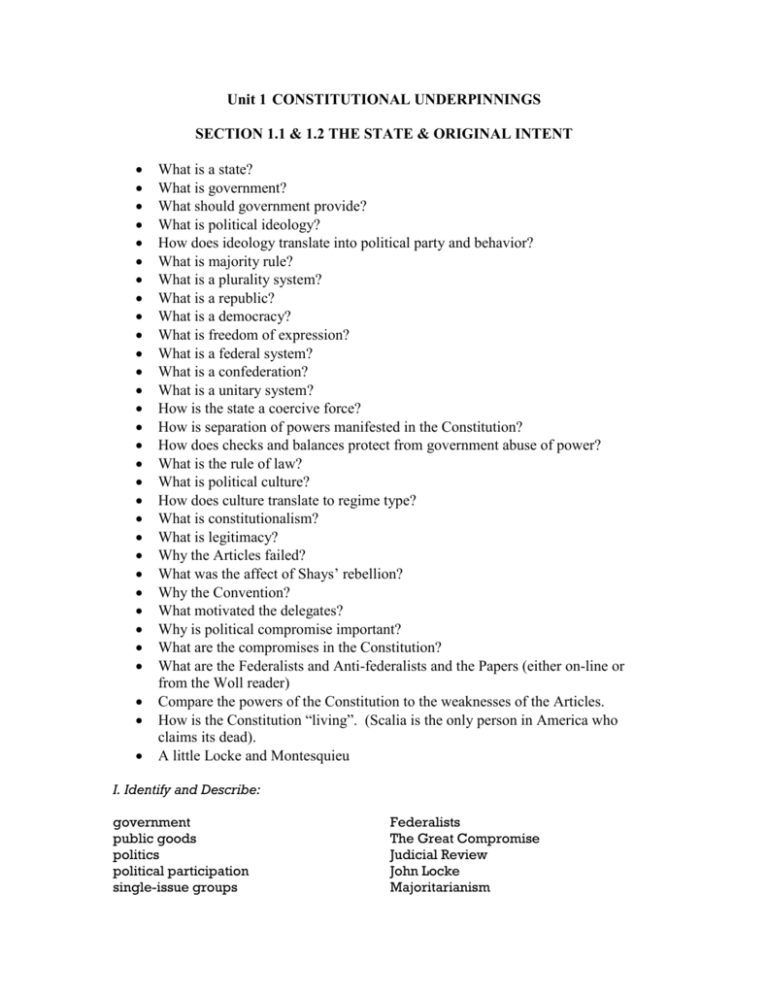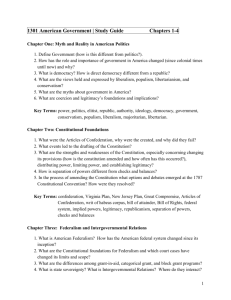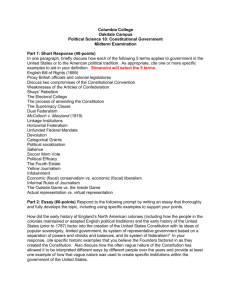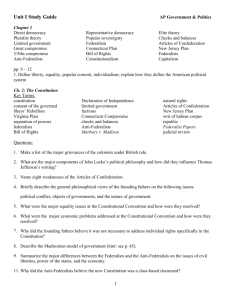Unit I.Know Sheet - Dr. Cash's AP US Government & Politics
advertisement

Unit 1 CONSTITUTIONAL UNDERPINNINGS SECTION 1.1 & 1.2 THE STATE & ORIGINAL INTENT What is a state? What is government? What should government provide? What is political ideology? How does ideology translate into political party and behavior? What is majority rule? What is a plurality system? What is a republic? What is a democracy? What is freedom of expression? What is a federal system? What is a confederation? What is a unitary system? How is the state a coercive force? How is separation of powers manifested in the Constitution? How does checks and balances protect from government abuse of power? What is the rule of law? What is political culture? How does culture translate to regime type? What is constitutionalism? What is legitimacy? Why the Articles failed? What was the affect of Shays’ rebellion? Why the Convention? What motivated the delegates? Why is political compromise important? What are the compromises in the Constitution? What are the Federalists and Anti-federalists and the Papers (either on-line or from the Woll reader) Compare the powers of the Constitution to the weaknesses of the Articles. How is the Constitution “living”. (Scalia is the only person in America who claims its dead). A little Locke and Montesquieu I. Identify and Describe: government public goods politics political participation single-issue groups Federalists The Great Compromise Judicial Review John Locke Majoritarianism policymaking system linkage institutions policy agenda political issue policymaking institutions public policy democracy majority rule minority rights representation elite and class theory hyper-pluralism policy gridlock gross domestic product individualism amending process anti-Federalists Articles of Confederation Authoritarian regimes Bill of Rights Consent of the governed Direct democracy An Economics Interpretation of the Constitution Elite theory Electoral college European Enlightenment Federalist Papers Federalist #10 political ideology conservative liberal libertarian block grants categorical grants the “commerce clause” concurrent powers confederal systems creeping categorization delegated powers devolution revolution federal systems federalism II. Compare and contrast: government and politics Natural rights New Jersey Plan Pluralism Ratification Representative democracy Second Treatise on Government Shay’s Rebellion Social Contract State of Nature Three-Fifths Compromise Thomas Hobbes Virginia Plan monarchy totalitarianism oligarchy social contract theory direct democracy indirect democracy (representative democracy) republic political culture personal liberty equality popular consent popular sovereignty civil society individualism baby boom (s) Generation X Generation Y grants-in-aid system Loose construction Mandate National supremacy Necessary & Proper (elastic Clause) Nullification Reserved powers Revenue sharing Strict construction Unitary governments policy agenda and public policy policymaking system and linkage institutions policymaking system and political issue democracy and traditional democratic theory majority rule and minority rights democracy and representation pluralist theory, elite and class theory, and hyper-pluralism DO NOT GET TOO BOGGED IN HISTORY, JUST MAIN THEME Define, give examples and interrelate all of the terms above. Provide multiple examples for the terms and make connections between them. Use comparative political systems (regime types) to draw associations and differences. Examples should be vivid—Nazis, Fascists, communists, Maoists Country examples could include: Myanmar, China, Venezuela, Cuba, Russia, Japan, Iran, Iraq, Saudi Arabia, France SECTION 1.3 THE CONSTITUTION What does the constitution do? What are the three structures of government? What are the formal powers of each branch and examples? What are the checks and balances and separation of powers? How is impeachment political? How does judicial review work? What is original intent? What is congressional elaboration? How does appointment and confirmation work? How does the veto work? How does federalism work? What are the powers laid out in the constitution? How is the Constitution changed? I. Identify and describe: Constitution Declaration of Independence natural rights consent of the governed limited government Articles of Confederation Shays’ Rebellion U.S. Constitution factions republic Federalists Anti-Federalists Federalist Papers Bill of Rights Equal Rights Amendment Marbury v. Madison judicial review writ of habeas corpus New Jersey Plan Virginia Plan Connecticut Compromise separation of powers checks and balances republic confederation legislative branch electoral college extraordinary majority republicanism federalism implied powers supremacy clause Bill of Rights executive branch judicial branch Great Compromise II. Compare and contrast: natural rights and consent of the governed Constitution, Articles of Confederation, and U.S. Constitution New Jersey Plan, Virginia Plan, and Connecticut Compromise separation of powers and checks and balances limited government and republic Federalists and Anti-Federalists Marbury v. Madison and judicial review Objective 1: Discuss the importance of the English philosophical heritage, the colonial experience, the Articles of Confederation, and the character of the founding fathers in shaping the agenda of the Constitution writers. 1. 2. 3. 4. 5. Make a list of the major grievances of the colonists under British rule. What are the major components of John Locke’s political philosophy and how did they influence Thomas Jefferson’s writings? Draw a schematic diagram of the American government under the Articles of Confederation. Make a list of the reasons why the Articles of Confederation failed. Briefly describe the general philosophical views of the founding fathers on the following issues: Human Nature, Political Conflict, Objects of Government, and Nature of Government. Objective 2: Identify the important principles and issues debated at the Constitutional Convention and describe how they were resolved. 6. 7. 8. What were the three major equality issues at the Constitutional Convention and how were they resolved? What were the major economic problems addressed at the Constitutional Convention and how were they resolved? Why did the founding fathers believe it was not necessary to address individual rights issues specifically in the Constitution? Objective 3: Explain the Madisonian model of limiting majority control, separating powers, and creating checks and balances. 9. Draw a schematic diagram of the Madisonian model of government. 10. Define the term “constitutional republic.” Objective 4: Understand the conflict between the Federalists and Anti-Federalists over the ratification of the Constitution. 11. Complete the following table summarizing the major differences between the Federalists and the Anti-Federalists on the issues of civil liberties, power of the states, and the econom. (Copy this chart onto a separate sheet of paper!) Issues Civil Liberties Power of the States Economy Federalists Anti-Federalists 12. Why did the Anti-Federalists believe the new Constitution was a class-based document? Objective 5: Describe the formal and informal processes by which the Constitution is changed in response to new items on the policy agenda. 13. What is meant by the “unwritten constitution”? 14. Describe the different ways in which a formal constitutional amendment might be adopted. 15. The text examines four ways the Constitution changes informally. Complete the following table, listing these ways, defining them, and giving an example for each. (Copy this chart onto a separate sheet of paper!) Informal Change Definition Example Objective 6: Evaluate the Constitution in terms of democracy and its impact on policymaking. 16. List and explain the five Constitutional amendments that expanded the right to vote. 17. In what ways does the Constitution expand and diminish the scope of government. SECTION 1.4 FEDERALISM What are the characteristics of federalism? What is good about federalism? How are powers shared? What is the role of the Supremes in federalism? Bush v Gore 2000. The supremacy clause---McCulloch v MD. The interstate powers—Heart of Atlanta v US The inherent powers Curtiss Wright Export v US Reserved and concurrent powers of states Preemption, federal mandates, unfunded mandates, state administration of federal programs Horizontal federalism Centrists & de-centrists; republicans, democrats Grants-in-aid Cooperative federalism, new federalism, marble cake theory, layer cake theory I. Indentify and Define sovereignty federalism dual federalism in-aid categorical grant formula grant project grant block grant states’ rights implied powers cooperative federalism elastic clause commerce clause grant government school district special district Unitary System Privileges & Immunities Clause 10th Amendment Reserved Powers Concurrent Powers Full Faith & Credit Clause Commerce Clause Dual Federalism Cooperative Federalism home rule policy entrepreneur pre-emption mandate restraint municipal government county Surface Transportation Act Categorical Grants Great Society New Federalism Reagan Revolution Block Grant Devolution Revolution Unfunded Mandates No Child Left Behind Act Preemption Sovereign Immunity Objective 1: Define federalism and explain why it is important to American government and politics. 1. Define the three ways of organizing a nation that were discussed in the text. 2. In what ways does federalism decentralize politics and policies? Objective 2: Describe how the Constitution divides power between the national and state governments and understand why the supremacy of the national government is the central principle of American federalism. 3. List the three items that are considered the supreme law of the land. 4. What is the significance of the 10th Amendment? 5. Explain the difference between enumerated powers and implied powers. Objective 3: Explain the nature of the states’ obligations to each other. 6. Describe the three general obligations that each state has to every other state under the Constitution. Objective 4: Explain how federalism in the United States has shifted from dual federalism to cooperative federalism. 7. How is dual federalism analogous to a layer cake and cooperative federalism analogous to a marble cake? 8. Explain the three general standard operating procedures of cooperative federalism. Objective 5: Describe the nature of fiscal federalism and how states and cities compete for federal grants and aid. 9. What is meant by “cross-over sanctions” and “cross-cutting requirements”? 10. Explain the two types of categorical grants. 11. For what reasons might a state or locality not want to receive federal aid? Objective 6: Explain the relationship between federalism and democracy, and how federalism contributes to and detracts from democracy. 12. List four advantages of federalism for democracy. 13. List four disadvantages of federalism for democracy. Objective 7: Understand how federalism has contributed to the scope of the national government. 14. How did industrialization increase the role of the national government? 15. Why don’t the states handle more issues?








